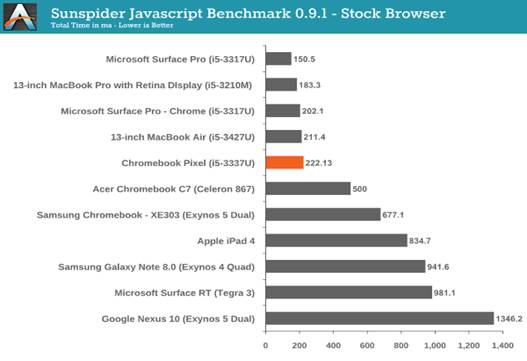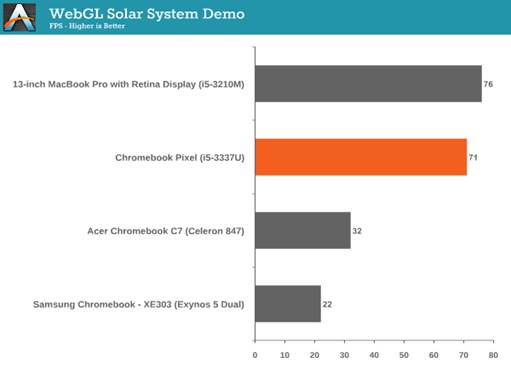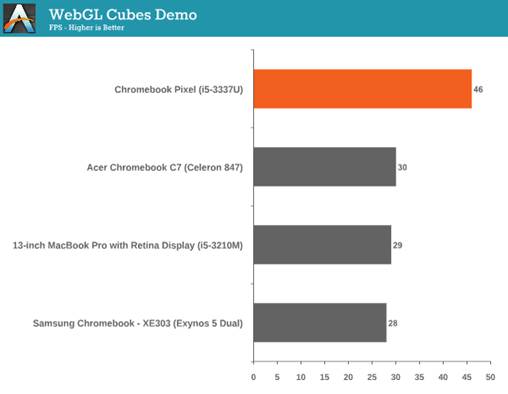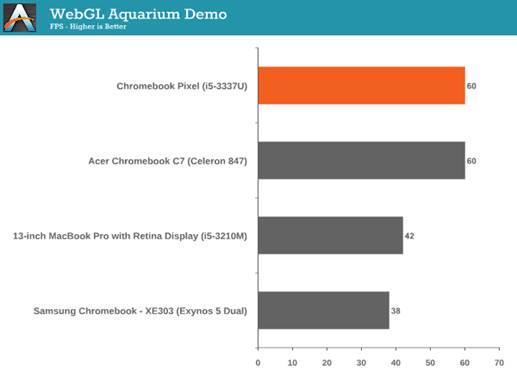Performance
A friend tells me to use Pixel and ask if
he can use it. After admiring design and hardware, he opens it and says, “but
basically this is just one iPad with the keyboard, right?" I do not know how
to answer. I never consider the comparison, I do not even think about including
iPad 4 as a reference point in this review. How is the Pixel like an iPad? It
takes me a while to process, but I think what you're saying that Pixel is mainly
for consumption in the same way iPad. Different approaches to the future of
computing, with the same defects. I have the same feeling from reading reviews
of Anand’s Surface Pro. Microsoft is very confident that this strategy is the
way to go, but in their case, insufficient hardware, provided laptop and tablet
experiences are not perfect. Meanwhile, the iPad has the excellent tablet
hardware and software but trying to complete the work on it is mainly insane.

Chrome
OS
Chrome OS, as the entry of Google into the
future of computing, there is relatively modest hardware. But in fact, even the
slow Atom Chromebook through the silicon present in the iPad 4. But faster
silicon and the fast browser never seem good enough. And that's where Pixel
jumps into. With Pixel, what we're seeing the modest silicon, similar
processors in the 13inch MacBook Air. However, what you have the competitive
performance with the 13inch better Retina MacBook Pro.

Pixel's
Intel Core i5-3337U SoC (under cover) and HM75 Chipset
As ever, too, the Chromebook test
application is a few items as container. The tests of our tablet have good
results here, along with a number of tests that we are combining to evaluate
Surface. However difficult test on Android, it proves to be much worse on
Chrome OS.
We start with the JavaScript tests,
including old friend, SunSpider. The test gives us a good idea of how far the
worst enemies about computing away from the top competitors and that do not
count the leading equipment. However, in the specific performance item, the
differences become small.

Sunspider
Javascript Benchmark 0.9.1
If you just want to prove Pixel to belong a
class separate from the history of the Chromebook, and tablets, it is here.
Pixel's performance here is close enough to the rMBP as to consider it is drawn,
Surface Pro in IE although seems to beat both clearly. It seems with this
hardware, the size is unlimited as long as nothing, so let's look at something
more serious.

Mozilla
Kraken benchmark
Mozilla Kraken is the next version in
JavaScript tests, with much heavier loads, though it quickly approached the
point under 1,000ms. Against the Surface Pro, Pixel leads here, even with the
running Chrome as a browser. There is only 1,000MHz speed difference between
the Pro and Pixel, not enough to see a difference about performance. This may
be a situation where the conceit of Chrome OS brings the results, by getting
rid of many other operating system, more resources can be devoted to the leading
task. Again, Pixel and rMBP locate side by side, regardless of clock speed
advantage up to 15% in favor of the rMBP. The rest, how?
Kraken and SunSpider do not create a very
comprehensive test, what we want that something may require heavy CPU, memory,
GPU and even the local repository. To have something to approach it, we add
WebXPRT from Principled Technologies. The real test simulates the real-world
web applications and will give us a better idea about the various platforms how
they are viewed from a wide angle lens.

WebXPRT
The rMBP has clear advantages when compared
to Pixel here, indicating a defect. We have not explored the WebXPRT enough to
say for sure that the ingredients are disclosed in each sub-test. Limitations
may have contributed to memory or clock speed advantage in rMBP that need a
longer test to reveal its value. However, the test still shows clearly in this
group, Surface Pro, Pixel and rMBP located on the projector, Surface Pro
persisted longer following.
WebGL is a tool of developers that is
quickly popular, although it still is the thing of technology demos. If gaming
is a serious part of the web as a platform, then a strong API much exist and
the supported hardware must run pretty well. When Acer Chromebook C7 comes to
us, we impress with the capabilities of Intel HD 2000 Graphics, when
outperformed Atom models and even Samsung's Mali GPU. Now we have the HD 4000,
in several versions. Checking WebGL capabilities is not easy, despite of many
technology demos, but we have selected several models and evaluation.

WebGL
Solar system Demo

WebGL
Cubes Demo

WebGL
Aquarium Demo
These results help to illustrate how
difficulty to compare the different platforms. Although rMBP and Pixel are
using Intel HD 4000 graphics, they are slightly different configuration. The
rMBP has the base clock speed advantageous (650MHz compared to the Pixel’s
350MHz) but they have the same maximum frequency (1.1GHz). That maximum number
is in theory, the actual of the laptop design is the temperature of the device that
will have a great influence on achieving maximum numbers or not, and it can be
maintained as long. There's also the fact that these devices run on different
operating systems, and thus these tests become more relevant to the processing
of their platform WebGL how based on similar hardware together. These loose
results show the superiority on Chrome OS, less so on Chrome on OS X.
The WebGL aquarium test was special
anomalies, with Pixel reaches v-sync even after raising the number of visible
fish on 1,000. These tests are not proven advantages in graphics performance
for Pixel, but considering the WebGL graphics rendering capability. There are
direct relationships with Pixel and Chromebook line, and here we can say for
sure that in favor of the newcomer. Anand has been described in a Samsung
Chromebook (XE303) review. The same is true in the Acer C7. Pixel removes that
fear, and sets one performance milestone for WebGL, WebGL developers want to
seek the platform to help to promote them best not to look further.
But, after all, there is a particular
subjective reality that we have to discuss. Even owners of the PC workstation
also meet poor performance in their browser. The website is increasingly
complex, can create multiple threads in themselves and consumes large amount of
resources. Even when nothing much happens, some advertisers may be displayed on
the first column of text with scattered images, you can still see the shock and
lingering coffee while scrolling through pages. Or there is a long delay after
enabling an action in one web application before seeing the appropriate
reactions. The culprit may be the network. It may be related to the application
itself. Or maybe one of the background processes needs these compute cycles a
bit before dropping them to complete your tasks. Chrome OS removes that
problem, while eliminating to network delays. And the result is acceptable.
Even in Gmail, which was long derided due to slow performance, feels smoother
and faster. Playing the simple 2D game may be disappointed in the C7 or even my
MacBook Pro, but in the Pixel you have never noticed anything except v-sync.
There is something about this experience that can’t be measured with the tools
we have, but it's there and it's really good.